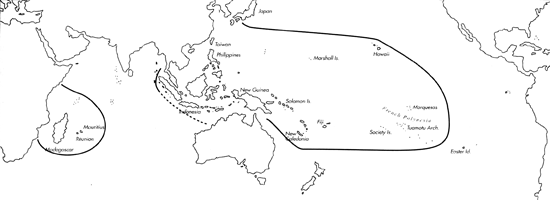Range: From Mozambique and Zanzibar to Marquesas and Hawaii (form pongo E. Africa to W. Thailand).
Description: Medium-sized to large, moderately solid to solid. Last whorl ovate to narrowly ovate; outline convex, less so or straight at adapical fourth and towards base; left side may be concave near base; sometimes sides nearly parallel centrally. Aperture distinctly wider at base than near shoulder. Shoulder subangulate to angulate or slightly carinate. Spire low, outline either concave, with apex projecting from an otherwise almost flat spire, or straight. Larval shell of 3-3.5 whorls, maximum diameter 0.9-1.0 mm. First 3-6 postnuclear whorls tuberculate, later whorls sometimes slightly carinate. Teleoconch sutural ramps flat, concave in late whorls, with 1 increasing to 2-4 spiral grooves that are weak in latest whorls. Last whorl with a few weak narrow spiral grooves at base.
| Shell Morphometry | ||
|---|---|---|
| L | 45-82 mm | |
| RW | 0.17-0.52 g/mm | |
| (L 45-68 mm) | ||
| RD | 0.47-0.60 | |
| PMD | 0.60-0.74 | |
| RSH | 0.02-0.10 | |
Ground colour white, variably suffused with orange to violet. Last whorl with spiral rows of orangish to reddish brown dots, dashes, bars and spots that alternate irregularly with white dots and often with triangular spots in some rows. Areas between usually with an incomplete to regular network of less prominent, orangish to reddish brown tent-like spots. Similarly coloured blotches also form interrupted spiral bands, within abapical third, above centre and sometimes below shoulder. Fine reddish brown axial lines may extend from shoulder to base. Form pongo (Pl. 43, Figs. 14-16) usually lacks reticulated triangular spots but has more prominent fine white axial lines; some specimens are irregularly clouded with orangish to reddish brown. Larval whorls and adjacent 2 postnuclear sutural ramps light red. Later sutural ramps with orangish to reddish brown radial streaks and blotches, often fusing in late whorls. In common form, aperture beige marginally, yellow-orange deep within; in form pongo, aperture orange-brown marginally, dark brown-red deeper within.
Periostracum very thin, translucent.
Animal white; dorsum of foot with reddish to dark brown lines and blackish brown lateral blotches; tentacles tipped with dark brown; siphon heavily mottled with dark brown dorso-laterally, immaculate at anterior end (Estival, pers. observ.). A red animal is reported from Papua New Guinea (Richards, pers. comm., 1988).
Habitat and Habits: Intertidal to about 240 m, most common from slightly subtidal to 50 m; on muddy sand, coral rubble and gravel, often beneath dead coral rocks, outside and inside the reef. Form pongo reported from slightly subtidal to about 20 m. Common form of C. bullatus known to feed on fishes and mollusks after nightfall and to be preyed upon by skates and stingrays as well as molluscivorous Conidae (McDowall, 1974).
Discussion: C. bullatus cannot be confused with any of its congeners. C. julii differs in having a narrower aperture and more ventricosely conical last whorl (PMD 0.69-0.78) with orange to brown wavy axial lines rather than complex spiral rows of orange to brown markings. C. bullatus form pongo (Pl. 43, Figs. 14-16) is recorded from Indian Ocean localities, while its occurrence in the W. Pacific (reports from E. China Sea and Admiralty Is.) has to be verified. It co-occurs with with the common form of C. bullatus in Zanzibar.

C. bullatus range map
This section contains verbatim reproductions of the accounts of 316 species of Conus from the Indo-Pacific region, from Manual of the Living Conidae, by Röckel, Korn and Kohn (1995). They are reproduced with the kind permission of the present publisher, Conchbooks.
All plates and figures referred to in the text are also in Röckel, Korn & Kohn, 1995. Manual of the Living Conidae Vol. 1: Indo-Pacific Region.
The range maps have been modified so that each species account has it own map, rather than one map that showed the ranges of several species in the original work. This was necessary because each species account is on a separate page on the website and not confined to the order of accounts in the book.